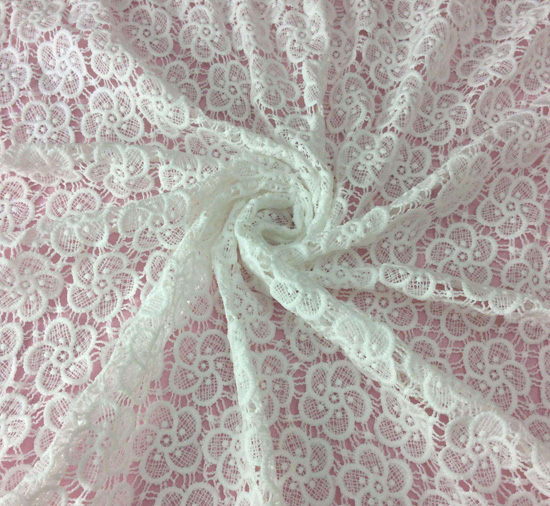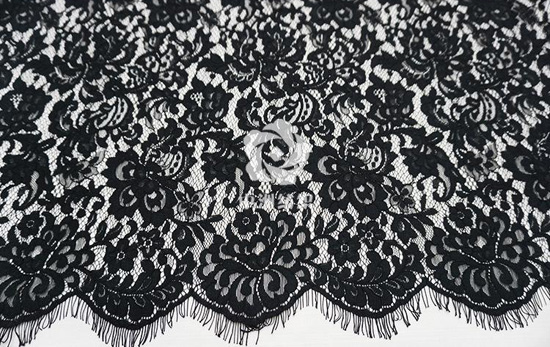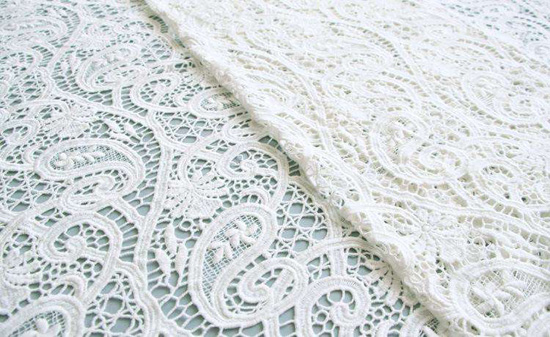Lace fabric
Lace fabric
Lace fabric usually refers to fabrics with embroidery, also called embroidery fabrics; currently lace fabrics are usually used as accessories in clothing because of their exquisite luxury and romance. The characteristics of breath have gradually increased in frequency as the main ingredient. Generally used in small tail or straight styles, covered with other fabrics, it can reflect the delicate figure of women. If lace fabric is used as an accessory material, it can be used in any style.
The main uses of lace fabrics include the following categories: 1. Spring and autumn clothing: mainly nylon, cotton, and polyester, combined with medium-thickness fabrics such as spandex. 2. Summer clothes: thin fabrics mainly made of nylon or polyester. 3. Winter clothing: mainly made of nylon, cotton, polyester, and thicker fabrics such as spandex. 4 Underwear: Mainly made of nylon and high-elastic fabrics, which are indispensable materials for sexy underwear.
Lace fabrics have a wide range of uses and can cover the entire textile industry. All textiles can be added with some beautiful lace elements.

Chinese name lace fabric
Foreign name LACE
Category Spring Clothing and Autumn Clothing
Application covers the entire textile industry
Types: stretch lace fabric/non-elastic lace
Machine warp knitting machine/computer machine/lace machine
Introduction to lace fabric
Lace fabrics are divided into elastic lace fabrics and non-elastic lace fabrics, collectively called lace fabrics.
The composition of elastic lace fabric is: 10% spandex + 90% nylon.
The composition of non-elastic lace fabric is: 100% nylon. This fabric can be dyed in a single color.
100% polyester. This fabric can be dyed in a single color.
85% cotton + 15% nylon. This fabric can be dyed in a single color
65% nylon + 35 polyester. This kind of fabric can be dyed bi-color, that is, dyed in two colors.
Lace fabric is widely used in women’s underwear due to its light and transparent texture, elegant and mysterious artistic effect.

Lace fabrics are divided into 6 types
1. Elastic lace fabric (nylon, polyester, nylon, cotton, etc.)
2. Non-elastic lace fabric (all nylon, all polyester, nylon cotton, polyester cotton, all cotton, etc.)
3. High fiber elastic jacquard lace
The main components of fiber high-elastic jacquard lace are made of polyester fiber and spandex. This fabric has good corrosion resistance and abrasion resistance, which makes up for the easily damaged textile structure of jacquard lace and makes the fabric less likely to deform.
4. Mesh jacquard lace
Mesh jacquard lace is made of polyester fiber and cotton, which makes the lace fabric more upright in shape and will not shrink. This kind of lace fabric is easy to clean, corrosion-resistant, and the overall structure is relatively stable and easy to wear. It’s also more comfortable to stand up.
5. Positioning lace
The main components of positioning lace are made of polyester fiber and cotton. The fabric has a specific shape and will not shrink, is easy to clean, and is corrosion-resistant. Since the positions of the patterns on the lace are relatively fixed, This increases the difficulty of cutting, but also improves the beauty of the clothing.
6. Crocheted cotton lace
This kind of lace fabric is different from other lace forms. Its craftsmanship is all crocheted, thus creating a hollow beauty. The fabric composition is nearly 100% cotton, but it will still add >3% Made of nylon, this can ensure good comfort, water absorption and perspiration, while also effectively preventing shrinkage or deformation.
Lace fabrics can be divided into types according to their types and characteristics
Elastic lace fabrics and non-elastic lace fabrics are collectively called lace fabrics.
The main components of elastic lace fabric are: spandex and nylon; (the usual ratio is spandex 10% + nylon 90%). The composition of non-elastic lace fabric is: 100% nylon; this fabric can be dyed in a single color. If it is made of 100% polyester; this fabric can be dyed in a single color. If it is made of 85% cotton + 15% nylon; then this fabric can be dyed in a single color; if it is made of 65% nylon + 35 polyester. This kind of fabric can be dyed with two colors, that is, two dyeing colors.

The difference between composite lace fabric and lace fabric
The difference between composite lace fabric and lace fabric is that composite lace fabric uses various patterns of lace, with TPU or PTFE in the middle, and the base fabric is made of velvet fabrics such as corduroy, polar fleece and other composite fabrics.
Lace fabrics are divided into elastic lace fabrics and non-elastic lace fabrics, collectively called lace fabrics. The composition of elastic lace fabric is: 10% spandex + 90% nylon. The composition of non-elastic lace fabric is: 100% nylon. This fabric can be dyed in a single color.
Why does lace fabric need to be composited? Advantages of lace composite fabric:
1. The texture is soft and very comfortable to touch;
2. The density of the fabric is relatively high, and it has good protection against cold and wind;
3. No wrinkles, no pilling, and good wear resistance;
4. The color is relatively high and looks high-end and classy.
Uses of lace fabric
Lace fabrics have a wide range of uses and can cover the entire textile industry. All textiles can add some beautiful lace elements. Lace is relatively thin! Even if it is a multi-layered design, it will not feel very heavy. Because it is thin, it will give people a cool feeling, and this design tends to be sweet! Lace fabric is light and thin because of its texture Transparent, with elegant and mysterious artistic effects, it is widely used in women’s underwear.
Lace fabric maintenance and cleaning:
Characteristics of lace fabric: This kind of lace fabric is different from other lace forms. Its craftsmanship is all crocheted, creating a hollow effect. In terms of fabric composition, the cotton content is close to 100%, but >3% nylon will still be added, which can ensure good comfort, water absorption and perspiration while effectively preventing shrinkage and deformation.
Lace fabrics are recommended to be hand washed gently and folded to dry. Can be ironed at low temperatures. The change in the role of lace from accessories to fabrics has brought a new lace trend to the fashion industry. However, this lace trend also has certain limitations. As lace is used as a fabric, it still has its own inseparable wearing characteristics, such as strong transparency and easy snagging and unraveling. Therefore, various special factors must be considered in the design of lace clothing. The transformation of lace from accessories to fabric is feasible and has good development prospects. The above is all the content about lace fabrics introduced by the editor of Aizhuang.com. sdfwrewrgtrhrt
Disclaimer:
Disclaimer: Some of the texts, pictures, audios, and videos of some articles published on this site are from the Internet and do not represent the views of this site. The copyrights belong to the original authors. If you find that the information reproduced on this website infringes upon your rights, please contact us and we will change or delete it as soon as possible.
AA






